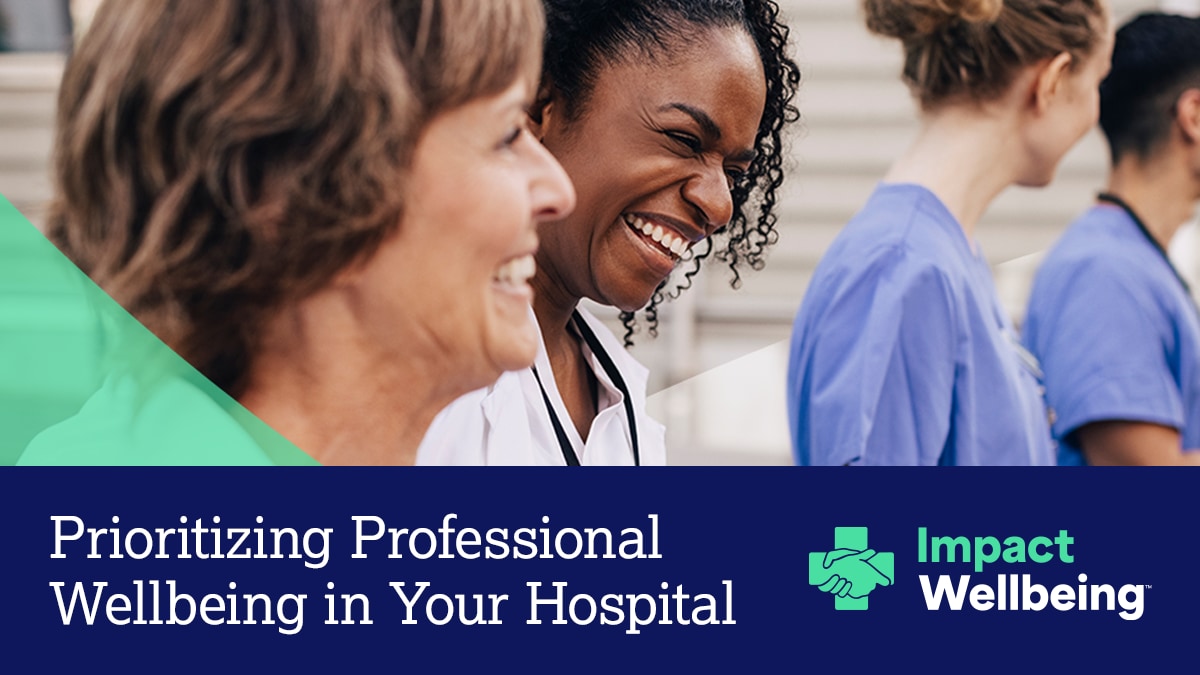At a glance
Hospital leaders can promote professional wellbeing in their workforce by communicating with staff, modeling wellbeing, and ensuring a safe work environment.
Introduction
You care about your workforce, but it can be hard to know where to focus to effectively improve professional wellbeing. Addressing workplace policies and practices is the best way to reduce burnout and strengthen professional wellbeing.1
NIOSH's Impact Wellbeing™ campaign has the resources to help hospital leaders build systems where healthcare workers thrive.

Why focus on professional wellbeing?
- According to the National Academy of Medicine, between 35% and 45% of nurses and physicians and 40% to 60% of medical students and residents report symptoms of burnout.1
- A 2023 Vital Signs report found that positive working conditions, such as trust in management and supervisor help, were associated with lower odds of poor mental health symptoms and burnout.2
- Healthcare worker burnout may impact the quality and safety of patient care, including increased medical errors and hospital-acquired infections among patients.345
By identifying and making practical operational adjustments, you can improve retention and help healthcare workers continue doing what they do best—delivering the highest quality patient care. 6
Make professional wellbeing a core part of your workplace
Show your commitment through action
Communicate often with your staff
Clear, consistent, and two-way communication with staff is an essential part of professional wellbeing. Maintaining transparent, ongoing communication with your workforce builds trust and shows that you are committed to professional wellbeing.7
Impact Wellbeing offers resources to help hospital leaders communicate effectively with their staff about mental health, burnout, and professional wellbeing efforts.
Model professional wellbeing practices for your workforce
Improved professional wellbeing starts with leaders committing to and modeling positive workplace culture practices. Research shows that supportive leadership can be an important factor in reducing the negative effects of job stress.89 It is critical to collaborate with your workforce when promoting a positive workplace culture.10 Give workers more flexibility and control over their working conditions and schedules whenever possible. Ask employees how their working conditions and schedules can better support their safety, health, and wellbeing.
How hospital leaders run their departments have wide ranging effects. It directly impacts their ability to have a strong workplace culture, cultivate an engaged workforce, and deliver high-quality patient care. Here are three ways you can model professional wellbeing in your hospital:
Implement supportive supervision. Train front-line supervisors in supportive supervision so they can help their staff balance their work responsibilities. Workers struggling to balance their work and home responsibilities experience increased stress.11
Normalize conversations about seeking mental health services. Nine out of 10 employees appreciate when their leaders share stories of getting support.12 Your staff wants to hear from you. Encouraging staff to get help if they need it sends a powerful message that will help them feel safe. For tips on having conversations on mental health, see the Health Action Alliance's leadership storytelling guide and conversation guide for managers.
Promote a culture of safety within your organization. Building a culture of trust with your workforce is an essential first step to addressing violence and harassment. Strategies from the Workplace Change Collaborative can help you make safety a core value at your workplace.

Case study: California nurse-to-patient staffing ratios
Ensure a safe work environment
Even before the pandemic, healthcare workers faced increasing cases of workplace violence and harassment.3 You can help healthcare workers feel safe at work by ensuring their wellbeing is valued as much as patient satisfaction. Here are some steps you can take to prioritize a safe work environment:
Remove barriers to reporting incidents of violence and harassment. Your hospital's reporting procedures should empower healthcare workers to come forward without fear of retaliation when incidents of violence occur. Make the process simple and transparent. Ensure your workforce knows that leadership takes incidents seriously and will act upon them in a timely manner.13
Provide violence prevention training to employees. Train supervisors and employees on how to respond when witnessing harassment, discrimination, bullying, or violence in the workplace. NIOSH's free online course, Workplace Violence Prevention for Nurses, offers continuing education credits. The American Hospital Association recommends bystander training and cognitive rehearsal training in its suicide prevention toolkit.
Support your workforce after upsetting events. Ensure that worker safety and wellbeing are valued as much as patient satisfaction in these conversations. The American Hospital Association developed a framework for providing trauma support to healthcare workers following an incident or threat of violence.
Ensure adequate staffing. Adequate staffing can improve both worker and patient safety. Explore resources from the Workplace Change Collaborative for guidance on safe and appropriate staffing, optimizing teams, and reducing administrative burdens.

Success Story: How Trinity Health Implemented a Successful Violence Prevention Initiative
About
Impact Wellbeing was developed by NIOSH in collaboration with the Dr. Lorna Breen Heroes' Foundation to support hospital leaders, and in turn their healthcare workforce, to improve professional wellbeing.
Total Worker Health® is a registered trademark of the U.S. Department of Health and Human Services (HHS).
- National Academies of Sciences, Engineering, and Medicine [2019]. Taking action against clinician burnout: A systems approach to professional well-being. Washington, DC: The National Academies Press.
- Nigam JA, Barker RM, Cunningham TR, Swanson NG, Chosewood LC [2023]. Vital Signs: Health Worker–Perceived Working Conditions and Symptoms of Poor Mental Health — Quality of Worklife Survey, United States, 2018–2022. MMWR Morb Mortal Wkly Rep 2023;72:1197–1205.
- U.S. Surgeon General [2022]. Addressing health worker burnout: The U.S. Surgeon General's advisory on building a thriving health workforce. Washington, DC: Office of the Surgeon General.
- Trockel M, Menon N, Rowe S [2020]. Assessment of physician sleep and wellness, burnout, and clinically significant medical errors. AMA Netw Open 3(12):e2028111.
- Salyers MP, Bonfils KA, Luther L [2017]. The relationship between professional burnout and quality and safety in healthcare: A meta-analysis. J Gen Intern Med 32:475–482.
- National Academy of Medicine [2022]. National plan for health workforce well-being. Washington, DC: The National Academies Press.
- Centers for Disease Control and Prevention [2018]. Health communication playbook: Resources to help you create effective materials. Atlanta, GA: Centers for Disease Control and Prevention.
- Allen TD [2001]. Family-supportive work environments: The role of organizational perceptions. J Vocat Behav 58(3):414–435.
- Hammer LB, Kossek EE, Yragui NL, Bodner, TE, Hanson, GC [2009]. Development and validation of a multidimensional measure of family supportive supervisor behaviors (FSSB). J Manage 35(4):837–856.
- Flin R, Fletcher G, McGeorge P, Sutherland A, Patey R [2003]. Anaesthetists' attitudes to teamwork and safety. Anaesthesia 58(3):233–242.
- Kossek EE, Hammer LB, Kelly EL, Moen P [2014]. Designing work, family & health organizational change initiatives. Organ Dyn 43(1): 53.
- Health Action Alliance [n.d.]. Workplace mental health: Tips for sharing your story. Los Angeles, CA: Health Action Alliance.
- NIOSH [2020]. Workplace violence prevention for nurses: Prevention strategies for organizations. U.S. Department of Health and Human Services, Centers for Disease Control and Prevention, National Institute for Occupational Safety and Health.
